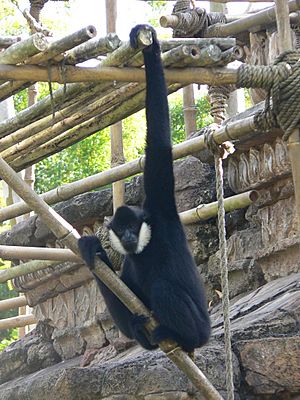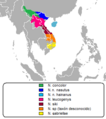Nomascus facts for kids
Quick facts for kids Nomascus |
|
|---|---|
 |
|
| Northern white-cheeked gibbon Nomascus leucogenys |
|
| Scientific classification |
|
| Kingdom: | Animalia |
| Phylum: | Chordata |
| Class: | Mammalia |
| Order: | Primates |
| Suborder: | Haplorhini |
| Infraorder: | Simiiformes |
| Family: | Hylobatidae |
| Genus: | Nomascus Miller, 1933 |
| Species | |
|
Nomascus concolor |
|
 |
|
| Range map of Nomascus species | |
Nomascus is a special group of gibbons. Gibbons are a type of ape known for their amazing ability to swing through trees. Nomascus is the second most common genus (a group of closely related species) of gibbon. There are six different species in this group. These gibbons were first thought to be a smaller part of a larger gibbon family called Hylobatidae.
Contents
What are Nomascus Gibbons?
Nomascus gibbons are medium-sized apes. They are famous for their loud, beautiful songs. These songs help them communicate across their forest homes. They are also known for their long arms. These arms are perfect for swinging from branch to branch.
Appearance and Features
Nomascus gibbons have sleek bodies. Their fur color can vary. Many species have dark fur. Some males are black, while females might be lighter. Young gibbons often start with one color and change as they grow. A cool feature is that some species have white cheeks or crests of hair on their heads. This helps tell them apart. Unlike monkeys, gibbons do not have tails.
Where Nomascus Live
Nomascus gibbons live in the tropical rainforests of Southeast Asia. You can find them in countries like Vietnam, Laos, Cambodia, and southern China. They prefer dense forests. These forests provide plenty of trees for them to live in. They also offer food and shelter.
Forest Homes
These gibbons spend almost all their lives in the trees. They rarely come down to the ground. Their forest homes are very important. They need tall trees to swing and sleep in. The trees also provide their main food sources.
Daily Life of a Nomascus Gibbon
Nomascus gibbons are very active during the day. They wake up early to sing and find food. Their days are filled with movement and social interactions.
Diet and Eating Habits
Nomascus gibbons are mostly herbivores. Their diet mainly consists of fruits. They love ripe fruits found in the forest. They also eat leaves, flowers, and sometimes insects. This varied diet helps them get all the nutrients they need.
Finding Food
They use their sharp eyesight to spot food. Their long arms help them reach fruits on thin branches. They are very good at finding food high up in the trees.
Movement and Travel
One of the most amazing things about Nomascus gibbons is how they move. They use a special way of moving called brachiation. This means they swing arm-over-arm through the trees. They can move very fast this way. They can cover long distances quickly.
Swinging Through Trees
Brachiation is like flying through the forest. They grab a branch with one hand. Then they swing their body forward. They grab the next branch with the other hand. This allows them to travel safely above the forest floor.
Social Life and Communication
Nomascus gibbons live in small family groups. A typical group includes a male, a female, and their young offspring. They are known for being monogamous. This means a male and female pair stay together for life.
Singing Together
Their most famous communication is their singing. Each morning, the family group sings a duet. The male and female sing together. Their songs are very loud and can be heard far away. These songs help them mark their territory. They also help other gibbons know where they are. Each species has its own unique song.
Reproduction and Life Cycle
Nomascus gibbons reproduce slowly. Females usually give birth to one baby at a time. The baby is born after about seven months of pregnancy.
Raising Young
Baby gibbons are very dependent on their mothers. They cling to their mother's fur for the first few months. Both parents help raise the young. The young gibbons stay with their family group for several years. They learn important skills from their parents. These skills include how to find food and how to sing.
Growing Up
Young gibbons slowly become more independent. They start to practice swinging and foraging on their own. They reach adulthood around 8 to 10 years old. Then they might leave their family group to find a mate.
Conservation Status
Sadly, many Nomascus species are in danger. They face serious threats in their natural homes.
Threats to Nomascus
The biggest threats are habitat loss and poaching.
- Habitat Loss: Forests are being cut down for farming, logging, and building. This leaves less space for gibbons to live.
- Poaching: Some gibbons are hunted illegally. They are sometimes captured for the pet trade.
Protecting Nomascus
Many groups are working to protect Nomascus gibbons. They are trying to save their forest homes. They also work to stop illegal hunting. Protecting these amazing apes is important for the health of our planet.
Images for kids
See also
 In Spanish: Nomascus para niños
In Spanish: Nomascus para niños



